Maida Hill
Maida Hill, Westminster
A shifting and lesser-known locality situated somewhere to the south of Maida Vale

The fields here attracted little attention until the opening of the Paddington branch of the Grand Union Canal in 1801. Within a few years the first villas were built on Hill House fields – the highest part of Paddington at 120 feet (37 metres) above sea level – together with a pub named the Hero of Maida. The hero was Major-General Sir John Stuart, who in 1806 led British troops to victory over a larger French force on the plain of Maida in southern Italy.
By 1810 the locality was being marked as ‘Maida’ on maps. Shortly after this, construction work began on the Regent’s Canal, which branched off from the Grand Junction (now Grand Union) Canal at what is now Little Venice.
The Maida Hill tunnel, begun in 1812, was the first canal tunnel to be built in London and is the second longest, after Islington’s. Its route had to be altered to avoid the Portman estate, which had refused passage through its property.
The part of Edgware Road immediately north of the Regent’s Canal was originally called Maida Hill, and later Maida Hill East, while modern Maida Avenue (now considered part of Little Venice for most of its length) was formerly Maida Hill West.
The joke about how God created Yorkshire – ‘Maida Hill then Maida Vale’ – indicates the order in which the district developed, as the first houses went up here and then spread northwards. These early properties were built in an Italianate style that was distinctively different from the later look of Maida Vale.
In 1868 the whole stretch of the former Edgware Road north of the canal was united as Maida Vale and Maida Hill’s name faded into obscurity for a while. It was later revived to identify the area to the south-west of Shirland Road, well to the west of its point of origin. What is now Maida Hill was called St Peter’s Park when it was built up from the mid-1860s. It was a squatting hotspot in the 1970s and is now popular with young singles.
The author Wilkie Collins entered Maida Hill Academy in 1835.
In Graham Greene’s novel Loser Takes All, Bertram plans to get married at the fictional church of St Luke’s, Maida Hill, but trouble ensues when the wedding is switched to Monte Carlo.
Pre-punk rockers the 101ers, who mutated into The Clash, took their name from the house number of their squat in Walterton Road, now replaced by a low-rise block of flats. The band played a weekly residency at the nearby Chippenham public house.
